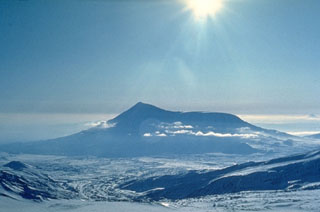Report on Tolbachik (Russia) — 12 December-18 December 2012
Smithsonian Institution / US Geological Survey
Weekly Volcanic Activity Report, 12 December-18 December 2012
Managing Editor: Sally Sennert.
Please cite this report as:
Global Volcanism Program, 2012. Report on Tolbachik (Russia) (Sennert, S, ed.). Weekly Volcanic Activity Report, 12 December-18 December 2012. Smithsonian Institution and US Geological Survey.
Tolbachik
Russia
55.832°N, 160.326°E; summit elev. 3611 m
All times are local (unless otherwise noted)
KVERT reported that the S fissure along the W side of Tolbachinsky Dol, a lava plateau on the SW side of Tolbachik, continued to produce very fluid lava flows that traveled 17-20 km during 7-17 December. Strong seismicity was detected. Ash plumes rose less than 1 km and drifted in multiple directions, and at least two cones grew above the fissure. A very large thermal anomaly on the N part of Tolbachinsky Dol was visible in satellite imagery. The Aviation Color Code remained at Orange.
Geological Summary. The massive Tolbachik volcano is located at the southern end of the Kliuchevskaya volcano group. The massif is composed of two overlapping, but morphologically distinct, volcanoes. The flat-topped Plosky Tolbachik shield volcano with its nested Holocene calderas up to 3 km in diameter is located east of the older and higher sharp-topped Ostry Tolbachik stratovolcano. The summit caldera at Plosky Tolbachik was formed in association with major lava effusion about 6,500 years ago and simultaneously with a major southward-directed sector collapse of Ostry Tolbachik. Long rift zones extending NE and SSW of the volcano have erupted voluminous basaltic lava flows during the Holocene, with activity during the past two thousand years being confined to the narrow axial zone of the rifts. The 1975-76 eruption originating from the SSW-flank fissure system and the summit was the largest historical basaltic eruption in Kamchatka.

